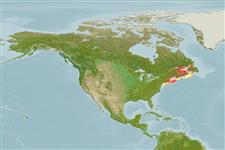>
Gadiformes (Cods) >
Gadidae (Cods and haddocks)
Etymology: Microgadus: Greek, mikros = samll + Latin, gadus = a fish, cod? (Ref. 45335); tomcod: Not available. See CoF (Eschmeyer, April 2006, Ref. 56787)..
More on author: Walbaum.
Environment: milieu / climate zone / depth range / distribution range
Ökologie
seewasser; süßwasser; brackwasser demersal; anadrom (Ref. 26213); tiefenbereich 0 - 69 m (Ref. 57178). Temperate; 54°N - 36°N, 76°W - 56°W (Ref. 86798)
Northwest Atlantic: southern Labrador in Canada to Virginia in USA.
Size / Gewicht / Alter
Maturity: Lm ? range ? - ? cm
Max length : 38.1 cm TL Männchen/unbestimmt; (Ref. 5951)
Rückenflossenstacheln (insgesamt) : 0; Afterflossenstacheln: 0. Body elongated; head small; eyes relatively small. Pelvic fins with a slightly elongated filament. Olive green brown or yellow dorsally, paler ventrally; with dark mottling on sides and fins.
Found in coastal, brackish and fresh water, landlocked in several lakes. Feeds mostly on small crustaceans, (especially shrimps and amphipods); also worms, small mollusks, squids and fishes (smelt, sticklebacks, striped bass, alewives, shed, herring and sculpins (Ref. 5951)) (Ref. 1371).
Life cycle and mating behavior
Maturities | Fortpflanzung | Spawnings | Egg(s) | Fecundities | Larven
Oviparous, sexes are separate (Ref. 205).
Cohen, D.M., T. Inada, T. Iwamoto and N. Scialabba, 1990. FAO species catalogue. Vol. 10. Gadiform fishes of the world (Order Gadiformes). An annotated and illustrated catalogue of cods, hakes, grenadiers and other gadiform fishes known to date. FAO Fish. Synop. 125(10). Rome: FAO. 442 p. (Ref. 1371)
IUCN Rote Liste Status (Ref. 130435)
Bedrohung für Menschen
Harmless
Nutzung durch Menschen
Fischereien: weniger kommerziell; Sportfisch: ja
Tools
Zusatzinformationen
Download XML
Internet Quellen
Estimates based on models
Preferred temperature (Ref.
123201): 2.7 - 12.6, mean 6.4 °C (based on 144 cells).
Phylogenetic diversity index (Ref.
82804): PD
50 = 0.7500 [Uniqueness, from 0.5 = low to 2.0 = high].
Bayesian length-weight: a=0.00398 (0.00186 - 0.00854), b=3.13 (2.94 - 3.32), in cm total length, based on LWR estimates for this (Sub)family-body shape (Ref.
93245).
Trophic level (Ref.
69278): 3.8 ±0.50 se; based on food items.
Widerstandsfähigkeit (Ref.
120179): mittel, Verdopplung der Population dauert 1,4 - 4,4 Jahre. (Assuming tm=2-4).
Fishing Vulnerability (Ref.
59153): Low to moderate vulnerability (28 of 100).
Climate Vulnerability (Ref.
125649): High to very high vulnerability (75 of 100).
Nutrients (Ref.
124155): Calcium = 48 [26, 98] mg/100g; Iron = 0.354 [0.195, 0.622] mg/100g; Protein = 17.7 [16.4, 19.1] %; Omega3 = 0.414 [0.202, 0.847] g/100g; Selenium = 11.7 [5.8, 26.8] μg/100g; VitaminA = 13.4 [3.7, 47.0] μg/100g; Zinc = 0.656 [0.458, 0.956] mg/100g (wet weight);
